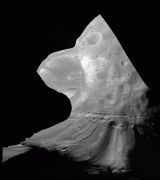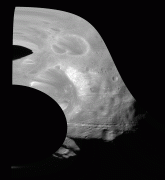Geert
Mar 29 2009, 01:23 AM
see
http://arxiv.org/abs/0903.3434QUOTE
The origin of the Martian moons Deimos and Phobos is controversial. One hypothesis for their origin is that they are captured asteroids, but the mechanism requires an extremely dense martian atmosphere, and the mechanism by which an asteroid in solar orbit could shed sufficient orbital energy to be captured into Mars orbit has not been well elucidated. Since the discovery by the space probe Galileo that the asteroid Ida has a moon "Dactyl", a significant number of asteroids have been discovered to have smaller asteroids in orbit about them. The existence of asteroid moons provides a mechanism for the capture of the Martian moons (and the small moons of the outer planets). When a binary asteroid makes a close approach to a planet, tidal forces can strip the moon from the asteroid. Depending on the phasing, the asteroid can then be captured. Clearly, the same process can be used to explain the origin of any of the small moons in the solar system.
Interesting theory.
nprev
Mar 29 2009, 01:53 AM
Interesting indeed. Hope the full paper is available freely online at some point. Would like to see how they address the fact that both moons' orbits are not only equatorial but quite circular.
(Don't get me wrong; still overwhelmingly believe that they're both captured objects, but IIRC explaining their regular orbits has been problematic.)
Geert
Mar 29 2009, 02:40 AM
QUOTE (nprev @ Mar 29 2009, 08:53 AM)

Would like to see how they address the fact that both moons' orbits are not only equatorial but quite circular.
In the
pdf they explain the circularization of the orbit by the of process of viscoelastic tidal damping, I can understand this would work for the larger moons of Jupiter/Saturn but I'm doubtful if this can fully explain a circular equatorial orbit for small body's as Phobos and Deimos in orbit around Mars?
IM4
Mar 29 2009, 10:31 AM
QUOTE (Geert @ Mar 29 2009, 02:40 AM)

In the
pdf they explain the circularization of the orbit by the of process of viscoelastic tidal damping, I can understand this would work for the larger moons of Jupiter/Saturn but I'm doubtful if this can fully explain a circular equatorial orbit for small body's as Phobos and Deimos in orbit around Mars?
Satellite size has a minor importance in this case. Tidal effects depend greatly on the distance to the main body (as ~a
6, see
formulas) and since Mars has a small Hill's sphere those distances won't be very much. Even quite distant initial orbit will circularize in no longer than ~1 billion years .
john_s
Mar 29 2009, 07:30 PM
A harder question for the capture hypothesis, I think, is why the inclination of the orbits is so low (1.1 and 1.8 degrees for Phobos and Deimos respectively). It's harder to damp inclination than it is to damp eccentricity (Triton, for example, has an inclination of 157 degrees and an eccentricity of zero). Unfortunately this paper doesn't mention inclination damping at all.
John.
ugordan
Mar 29 2009, 07:47 PM
I wondered about inclination, too. Is there any (tidally-related?) mechanism to reduce inclination that doesn't require drag/collisions with other particles as is the case with ring systems?
nprev
Mar 29 2009, 07:49 PM
Indeed, John. I was thinking of our own Moon as well, which is thought to be (essentially) primordial but still has 30 deg or so orbital inclination.
Of course, there seem to be at least three discrete ways to make/acquire moons. We're probably still a long way from a detailed understanding of these processes given all the possible variables.
ngunn
Mar 29 2009, 08:56 PM
Does there have to be an intermediate stage where a disc or rings are present to bring everything into the equatorial plane?
vk3ukf
May 23 2009, 09:18 AM
Hmm, can I go silly, why not, It was said that early in our systems history, the Earth was maybe hit by a large object and the debris formed the Moon. Perhaps Deimos and Phobos are hunks of Mars itself blasted into orbit by such collision in the early system of rogue objects that were eventually ejected or destroyed and partially absorbed. Maybe Mars could be surrounded by hunks of Earth, blasted into space by the collision that created the Moon. The grooves on Phobos could be, rock layers from a larger original planetary sized body. It's not hard to imagine a few fish, whales, trees and other unexpected things to be in space. Earth has been hit very hard a few times since life has been on it, to blast such material into space. There are bits of everything everywhere. I like to collect meteorites, can you tell?
Isn't it weird how so many objects have these one face toward the planet orbits.
Why do some moons rotate in relation to their parent body and others not, is this a clue to their formation?
There is probably some lumps of stuff ejected from other star systems floating around in ours somewhere, hope a little bits lands, or someone finds a bit that already has.
:-)
Hungry4info
May 23 2009, 04:00 PM
QUOTE (vk3ukf @ May 23 2009, 04:18 AM)

Maybe Mars could be surrounded by hunks of Earth, blasted into space by the collision that created the Moon. The grooves on Phobos could be, rock layers from a larger original planetary sized body.
A planet-planet collision would completely obliterate any such feature.
QUOTE
Isn't it weird how so many objects have these one face toward the planet orbits.
In my opinion, no.
Tidal effects synchronize the orbits of orbiting bodies over a period of time. The closer the satellite is to the orbited host, the sooner it will be locked into synchronous rotation.
QUOTE
There is probably some lumps of stuff ejected from other star systems floating around in ours somewhere, hope a little bits lands, or someone finds a bit that already has.
I wouldn't be surprised if some of those hyperbolic-orbit comets are from other solar systems, but I would be surprised if they were ejected from their home system through a planet-planet collision.
Greg Hullender
May 23 2009, 05:19 PM
QUOTE (vk3ukf @ May 23 2009, 02:18 AM)

Hmm, can I go silly, why not, . . .
Because this is a serious site, not a silly one. Lots of real scientists read and post here, and they're generally happy to answer serious questions.
QUOTE (vk3ukf @ May 23 2009, 02:18 AM)

Isn't it weird how so many objects have these one face toward the planet orbits.
Why do some moons rotate in relation to their parent body and others not, is this a clue to their formation?
I'd say this qualifies as a serious question. :-) Tidal forces cause this behavior in small bodies which orbit close to large ones. If you found a close-in moon that did rotate with respect to its planet, then you'd be entitled to speculate that it had been captured very recently. Exceptions (like Mercury and Hyperion) are very educational in their own right.
--Greg
Greg Hullender
May 23 2009, 05:27 PM
QUOTE (Hungry4info @ May 23 2009, 09:00 AM)

I wouldn't be surprised if some of those hyperbolic-orbit comets are from other solar systems, but I would be surprised if they were ejected from their home system through a planet-planet collision.
Everything I see, though, suggests that comets on hyperbolic orbits are local. Here's an example:
http://www.aanda.org/index.php?option=arti...1250.right.htmlFor my money, a truly extrasolar comet ought to have a lot more hyperbolic excess velocity than anything we've ever seen. The hyperbolic comets we do see are just barely hyperbolic -- like they came from the Oort cloud and got accelerated just a little bit by something.
--Greg
Holder of the Two Leashes
May 23 2009, 06:51 PM
QUOTE (ugordan @ Mar 29 2009, 01:47 PM)

I wondered about inclination, too. Is there any (tidally-related?) mechanism to reduce inclination that doesn't require drag/collisions with other particles as is the case with ring systems?
You would think that there would have to be. I've read from a number of sources that the axial tilt of Mars goes through some wild changes, with inclinations varying from zero degrees to past fifty. It just happens now to be tilted very similar to earth.
So the equator over time is dancing around quite a bit, but seems to be dragging the two moons along for the ride.
Hungry4info
May 24 2009, 12:11 AM
QUOTE ("ugordan")
I wondered about inclination, too. Is there any (tidally-related?) mechanism to reduce inclination that doesn't require drag/collisions with other particles as is the case with ring systems?
There's the Kozai effect, but... it seems to require the gravitational influence of another body (i.e. a planet orbiting a star in a wide binary system will undergo Kozai oscillations, e.g. HD 80606

But I don't understand the effect well enough to even begin to wonder if it can explain how the orbits of the two moons are coplanar. Perhaps Mars' gravitational field, being unevently distrubuted, could affect the orbits of the moons. (speculation)
Greg Hullender
May 24 2009, 01:03 AM
It's a tidal effect, and it's caused by the oblateness of the planet.
http://adsabs.harvard.edu/abs/1965AJ.....70....5GIf the axis of Mars moved, it'd fairly soon drag both moons back to orbiting over the equator.
--Greg
nprev
May 24 2009, 01:19 AM
What's interesting about Mars wrt tidal dynamics is that it has one pronounced bump: the Tharsis Bulge. It's apparently a fairly recent feature (<1 By), but it would be useful to understand its effect on the planet's Milankovitch cycles as well as on the orbital evolution of Phobos & Deimos.
vk3ukf
May 24 2009, 11:13 AM
Could the grooves on Phobos be fracture marks from actually being shattered by the Stickney impact but only gently moving apart a little only to meld back together?
Hungry4info
May 24 2009, 04:37 PM
Full inline quote removed
I'm no expert, but I would say it is possible.
Some of the newer images of Phobos show that the lines appear to be composed of several small craters. Or at least that my interpretation of it.
Shaka
May 24 2009, 10:29 PM
craters or sinkholes?
JohnVV
Sep 8 2009, 09:46 PM
QUOTE
Some of the newer images of Phobos show that the lines appear to be composed of several small craters
they don't look like strings of craters to me .More like stress fractures
an isis remapped image of ( PSP_007769_9015_BG13.cub ) to the shape model i am working on

Floyd
Sep 8 2009, 10:42 PM
Welcome JohnVV! Really impressive first post. It is interesting that the groves in the top half of your projection run horizontally (east-west??) and those in the lower half run perpendicular/vertically. Almost seems like the bottom half of Phobos got rotated 90 degrees.
JohnVV
Oct 1 2009, 05:10 AM
QUOTE
and those in the lower half run perpendicular/vertically. Almost seems like the bottom half of Phobos got rotated 90 degrees.
that is just from the shape model in ISIS3 that i made " ShapeModel = $base/dems/PhobosShapeNew.cub "
using the default lat/long from spiceinit
here it is without the "ShapeModel = Null ", and lat/long corrected with "qtie"

not mapped

sgendreau
Oct 25 2009, 08:52 PM
QUOTE (john_s @ Mar 29 2009, 11:30 AM)

A harder question for the capture hypothesis, I think, is why the inclination of the orbits is so low (1.1 and 1.8 degrees for Phobos and Deimos respectively).
John.
Could the large changes in obliquity be a factor? I've read that Earth's obliquity varies little because the Moon acts as an anchor -- so does the reverse hold as well?
remcook
Dec 11 2009, 11:52 AM
never mind
This is a "lo-fi" version of our main content. To view the full version with more information, formatting and images, please
click here.



